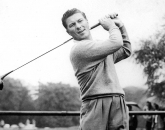
According to my learned colleague Denis Hutchinson, golf in the Western Hemisphere is dying on its feet because there are too many feet in a course. In other words, courses have got too long and difficult for the average club player, so the average club player has taken his ball and gone cycling.
According to a survey I read recently, in the UK in 1997 there were twice as many golfers as there were cyclists. That position has now just about totally reversed. Neither sport is cheap, although it's possible to cycle at a basic level a lot more cheaply than it is to play golf. Cost may be a factor in golf's decline but one suspects it's not the main reason. Denis is undoubtedly right that for some, and particularly the more senior brethren, the game has become too difficult.
But that cannot be the whole story. Equipment has apparently made the game much easier to play in the last twenty years, albeit it doesn't help the "average" player as much as the skilled top enders who generate the clubhead speed necessary to really compress the ball and launch it into a dangerously high orbit. My own belief is that while these are contributory factors, it's the pace of play that is the real killer. Just before Christmas, my wife, a one-handicapper, and a companion strolled round Bath Golf Club in two hours and thirty minutes. Strolled. Without impedance they were able to hit the ball, find it and hit it again, taking 70-something shots apiece. For most people nowadays though, a round of golf is at least a five-hour experience. Who can afford to do that on a regular basis? Ah yes, the professionals. What a lot they have to answer for. If golf is to survive its current serious decline, radical steps must be taken to dramatically reduce the time a round takes.
The aforementioned Denis was on the commentary team for the final tournament of 2014, the Alfred Dunhill Championship at Leopard Creek beside the Kruger National Park, where a plethora of exotic animals were on display. Scatological proof of the presence of nearby giraffes was provided by Ken Brown who tested the commentators with a number of different examples of excrement during the broadcasts. For some reason Denis stumbled on the giraffe poo. Former European Tour player Tony Johnstone, commentating for Sky TV, provided all the natural history expertise in a hugely impressive display of "bush" learning. I really had no idea that so much foliage passed through an elephant in a 24-hour period.
One of the few animals missing was the Tiger. Not a native of South Africa in recent times of course, but golf fans around the world will be hoping to spot the wounded big cat making a triumphant return in 2015. The 14-time Major champion is trying to go back in time with his new “swing consultant”, Chris Como, who has been selected to guide Tiger into a longer more fluid action; just like the one he used to know.
Pages
Click here to see the published article.











